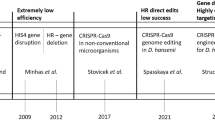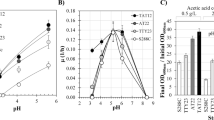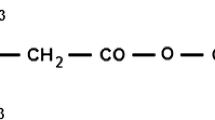Abstract
The highly thermosensitive and permeable mutants are the mutants from which intracellular contents including proteins can be released when they are incubated both in the low osmolarity water and at the nonpermissive temperature (usually 37°C). After mutagenesis by using nitrosoguanidine, a highly thermosensitive and permeable mutant named Z114 was obtained from the marine yeast Cryptococcus aureus G7a. Of the total protein, 65.3% was released from the mutant cells suspended in distilled water after they were treated at 37°C overnight. However, only 12.3% of the total protein was released from the mutant cells suspended in 1.0 M sorbitol solution after they were treated at 37°C overnight. We found that intracellular density of the mutant treated at 37°C was greatly decreased, and cell volume of the mutant treated at 37°C was increased due to the increased protein release. However, no significant changes in the intracellular density and cell volume of the mutant were observed when its cells suspended in 1.0 M sorbitol solution were treated at 37°C. It was found that no big changes in cell growth, protein content, vitamin C content, nucleic acid content, fatty acids, and amino acid compositions of both the mutant and its wild type were detected. Therefore, the highly thermosensitive and permeable mutant still can be a good candidate as single-cell protein. This means that the method used in this study is a simple and efficient way to release protein from the highly thermosensitive and permeable yeast mutant cells with high protein content.


Similar content being viewed by others
References
Alexandar I, Segundo PS, Venkov P, del Rey F, Vázquez de Aldana CR (2004) Characterization of a Saccharomyces cerevisiae thermosensitive lytic mutant leads to the identification of a new allele of the NUD1 gene. Intern J Biochem Cell Biol 36:2196–2213
Bradford MM (1976) A rapid and sensitive method for quantitation of microgra quantities of protein utilizing the principle of protein-dye binding. Anal Biochem 72:248–253
Brown MR, Barrett SM, Volkman JK, Nearhos SP, Nell JA (1996) Biochemical composition of new yeasts and bacteria evaluated as food for bivalve aquaculture. Aquaculture 143:341–360
Cabib E, Duran A (1975) Simple and sensitive procedure for screening yeast mutants that lyse at nonpermissive temperatures. J Bacteriol 124:1604–1606
Chi ZM, Kohlwein SD, Paltauf F (1999) Role of phosphatidylinositol (PI) in ethanol production and ethanol tolerance by a high ethanol producing yeast. J Ind Microbiol Biotech 22:58–63
Chi ZM, Liu J, Zhang W (2001) Trehalose accumulation from soluble starch by Saccharomycopsis fibuligera sdu. Enzyme Microb Technol 28:240–245
Chi ZM, Liu ZQ, Gao LM, Gong F, Ma C, Wang XH, Li HF (2006) Marine yeasts and their applications in mariculture. J Ocean University China 5:251–256
Feng DX, Zhao BG (1997) Evaluation of protein quality of the new feeds by using essential amino acid index (EAAI). China Feed 7:10–13
Gao LM, Chi ZM, Sheng J, Ni XM (2007) Single-cell protein production from Jerusalem artichoke extract by a recently isolated marine yeast Cryptococcus aureus G7a and its nutritive analysis. Appl Microbiol Biotechnol 77:825–832
Hancock RD, Galpin JR, Viola R (2000) Biosynthesis of L-ascorbic acid (vitamin C) by Saccharomyces cerevisiae. FEMS Microbiol Lett 186:245–250
Kochert G (1978) Quantitation of the macromolecular components of microalgae. In: Hellebust JA, Craigie JS (eds) Handbook of physiological methods: physiological and biochemical methods. Cambridge University of Press, Cambridge, pp 190–195
Patil RS, Ghormade V, Deshpande MV (2000) Chitinolytic enzymes: an exploration. Enzyme Microb Technol 26:473–483
Ratledge C (2004) Fatty acid biosynthesis in microorganisms being used for single cell oil production. Biochimie 86:807–815
Ravindra AP (2000) Value-added food: Single cell protein. Biotechnol Adv 18:459–479
Rhishipal R, Philip R (1998) Selection of marine yeasts for the generation of single cell protein from prawn-shell. Bioresour Technol 65:255–266
Sheng J, Chi ZM, Li J, Gao LM, Gong F (2007) Inulinase production by the marine yeast Cryptococcus aureus G7a and inulin hydrolysis by the crude inulinase. Proc Biochem 42:805–811
Strickland JDH, Parsons TR (1972) Kjehldahl method with ninhydrininish (low levels). In: Stevenson JC (ed) A practical handbook of seawater analysis. Bull: Fisheries Research Board of Canada, Ottawa, pp 227–236
Ueda M, Tanaka A (2000) Genetic immobilization of proteins on the yeast cell surface. Biotechnol Adv 18:121–140
Acknowledgements
This research was supported by grants 2006AA09Z403 from Hi-Tech Research and Development Program of China (863).
Author information
Authors and Affiliations
Corresponding author
Rights and permissions
About this article
Cite this article
Zhang, T., Chi, Z. & Sheng, J. A Highly Thermosensitive and Permeable Mutant of the Marine Yeast Cryptococcus aureus G7a Potentially Useful for Single-Cell Protein Production and its Nutritive Components. Mar Biotechnol 11, 280–286 (2009). https://doi.org/10.1007/s10126-008-9144-3
Received:
Accepted:
Published:
Issue Date:
DOI: https://doi.org/10.1007/s10126-008-9144-3




